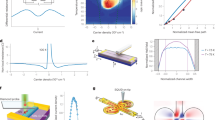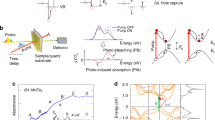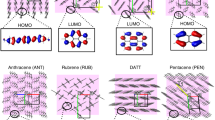Abstract
MATHEMATICAL theories about the conduction of electricity through solids have been detailed for conventional metals1. It is generally necessary to combine assumptions about the concentration of charge carriers with calculations about their probabilities of being scattered during flow. For synthetic metals the predominant scattering processes may be quite different, however. This may be so in lamellar solids after they have been converted into good electrical conductors by intercalation of electron donor or electron acceptor molecules between the layers. Such molecules are thought to form charge transfer bonds with the two-dimensional macromolecules that constitute the layers in the parent solids before intercalation. Even static aspects of probable charge transfer bond formation have not always received complete quantum mechanical formulation. Dynamic aspects (which may influence scattering processes during current flow) are even less completely described. This letter points out that scatter probabilities of current carriers injected by charge transfer may be markedly lower than in the more familiar ‘natural’ three-dimensional metals. This may help to explain high electrical conductivities of lamellar synthetic metals.
This is a preview of subscription content, access via your institution
Access options
Subscribe to this journal
Receive 51 print issues and online access
$199.00 per year
only $3.90 per issue
Buy this article
- Purchase on Springer Link
- Instant access to full article PDF
Prices may be subject to local taxes which are calculated during checkout
Similar content being viewed by others
References
Wilson, A. H. Cambridge University Press (1965).
McDonnell, F. R., Pink, R. C. & Ubbelohde, A. R. J. chem. Soc. 191 (1951).
Ubbelohde, A. R. Proc. Conf. Carbon, Buffalo, 329 (1957).
Gracey, J. P. V. & Ubbelohde, A. R. J. chem. Soc. 4089 (1955).
Parkyns, N. D. & Ubbelohde, A. R. J. chem. Soc. 2110 (1951).
Ubbelohde, A. R. Proc. R. Soc. A327, 289 (1972).
Ubbelohde, A. R. Proc. R. Soc. A321, 445 (1971).
Bottomley, M. J., Parry, G. S., Ubbelohde, A. R. & Young, A. D. J. chem. Soc. 5674 (1963).
Dresselhaus, G. & Dresselhaus, M. S. J. mat. Sci. Engng (in the press).
Ubbelohde, A. R. J. mat. Sci. Engng (in the press).
Ubblehode, A. R. Nature 268, 16 (1977).
Spain, I., Ubbelohde, A. R. & Young, D. A. Phil. Trans. R. Soc. A262, 345 (1967).
Ubbelohde, A. R. Carbon 7, 532 (1969); J. chim. Phys. No. Spécial 64 (1969).
Drummond, I. & Ubbelohde, A. R. J. Phys. E. Scient. Instrum. 10, 1114 (1977).
Author information
Authors and Affiliations
Rights and permissions
About this article
Cite this article
UBBELOHDE, A. ‘Low scatter’ conduction of electric charges through lamellar solids. Nature 271, 139–140 (1978). https://doi.org/10.1038/271139b0
Received:
Accepted:
Issue Date:
DOI: https://doi.org/10.1038/271139b0
Comments
By submitting a comment you agree to abide by our Terms and Community Guidelines. If you find something abusive or that does not comply with our terms or guidelines please flag it as inappropriate.



